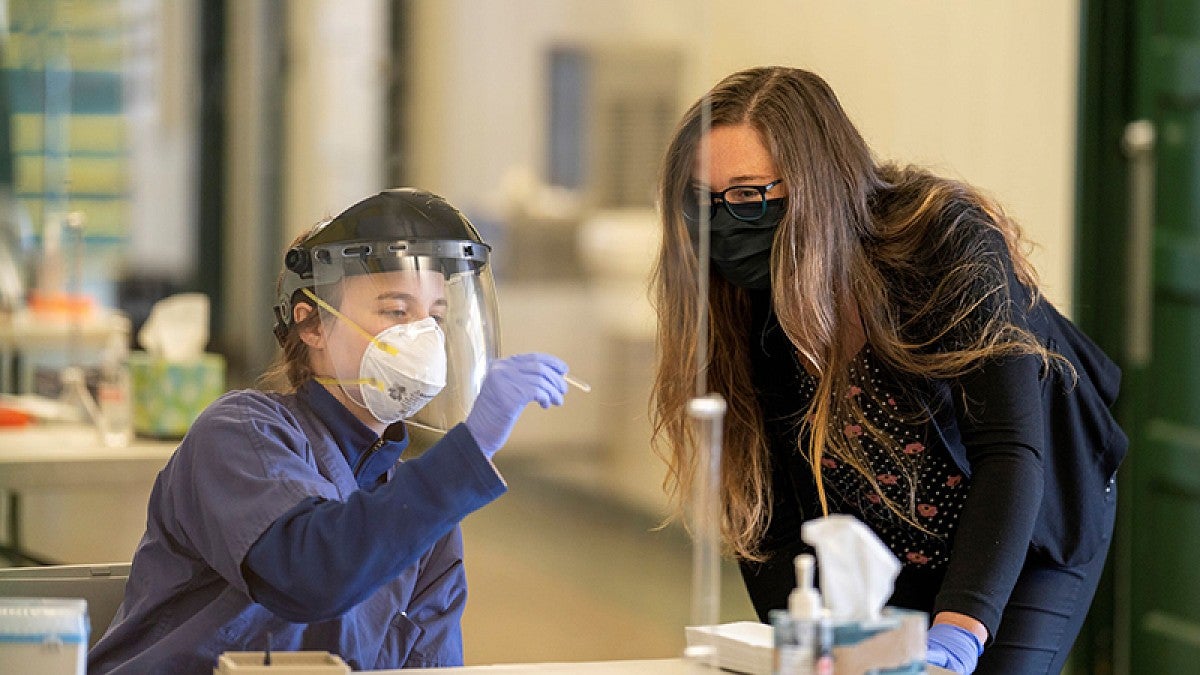Not long ago, McArthur Court would shake, rattle and rumble as boisterous Duck fans stomped the rafters, rooting for their hoops heroes.
Today, there’s not much action on the fabled floor. And while there are no fans around to cheer, the deeds taking place in the building are just as heroic.
Five days a week, student employees set up stations in Mac Court’s ticket booths and hallways to administer COVID-19 tests, helping to keep the UO community and residents of Lane County aware, healthy and safe. And like the legendary ball coaches of yore, Hannah Tavalire, the director of operations for the UO’s Monitoring and Assessment Program, known as MAP, gets the most out of the squad.

Tavalire has been getting the UO’s response done from the early days of the pandemic, although like many others who are involved, it wasn’t a job she planned.
After earning her doctorate in biology from Oregon State University, she cold-called researchers whose work she found interesting and caught on with the labs of UO scientists Bill Cresko and Leslie Leve, eventually landing an early-career scientist position with Leve’s group in the Prevention Science Institute. When the pandemic broke out, Tavalire stepped forward.
“I'm an infectious disease biologist, I want to help,” she said.
She started as the MAP’s scientific coordinator, at first acquiring samples from positive cases to help secure lab validation. Then it was thinking through the logistics of large-scale collection efforts for residence halls, matching proposed plans with emerging and ever-changing Centers for Disease Control and Prevention guidance and researching less-invasive alternatives to the deep nasal swab.
As the program found its groove, Tavalire was able to return to her research projects and ponder her next move. (She admits she’s been talking about working at the CDC “for 10 years.”)
But when she was asked to come back as the operations director — half time at first, but recently upped to full time — it was an easy decision.
“I thought, I really like the admin operations stuff,” she said. “It’s feels like a good fit for me, and I can really help to make a difference.”
“Hannah has held a strong passion for public health research since the day she started at UO,” said Leve, Lorry Lokey Chair in the College of Education. “It is a rarity to find a scholar as well-versed in the dual disciplines of biology and prevention science as she is. That unique combination of skills and training not only positioned her to excel in her research career but also to be the ideal leader of the operational activities of the COVID-19 MAP project.”
To date, the Monitoring and Assessment Program has administered more than 211,000 tests to Oregonians, including UO students on campus, members of Latinx and Hispanic communities, and K-12 students from the local and southern parts of the state.
Even with the high demand, there’s room for more community residents to take advantage of testing, Tavalire said. It’s free and accessible to community members as a public service, operated in cooperation with Lane County Public Health.
All those tests have helped people take precautions and prevent even more serious spread of infection. And there are even greater benefits.
“We've had the most brilliant minds in the world thinking about how to solve this one specific problem for the past two years, so we've had this rapidly accelerated diagnostic advancement,” Tavalire said. “Is this going to be a part of normal life for the next five to 10 years? No one can say, but I think we're in a really good place to be set up for success if we have to keep dealing with COVID, long term.”
—By George Evano, University Communications


